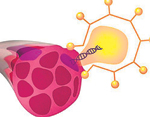Winning streak with a tinkered gene A relatively new criminal wave is sweeping through the world of sports - gene doping, a pernicious spin-off from the world of medicine and the life-saving technology of gene therapy. Welcome to the "Brave New World of Sports".
Imagine yourself as a spectator at the summer Olympics of 2008 in Beijing, China. Athletes are shattering records with relative ease as never before, leaving you and the world at large simply breathless. The tests for traditional performance enhancing drugs like anabolic steroids and testosterone keep coming up negative.
The scientific world is beginning to realise that all is not well. Have these athletes increased their strength and endurance in another way? Perhaps, and most likely the answer is YES. Their genes have been altered to satisfy their individual demands and needs. A relatively new criminal wave is sweeping through the world of sports - gene doping, a pernicious spin-off from the world of medicine and the life-saving technology of gene therapy. Welcome to the "Brave New World of Sports". Per Olaf Astrand once made a prophetic statement. He said "To become an Olympic athlete, choose your parents well". An effort, that at present belongs to the realms of fiction. However, athletes, coaches and trainers are well aware that talented sportsmen and women are gifted with exceptional genes. So, as at present, what remains to be done to increase the full potential of the talents and skills of a selected athlete, is to tinker with some of the nearly 35,000 or so genes, which our parents have randomly and faithfully bequeathed to us. We now know this, thanks to the successful completion of the 'Human Genome Project", an ambitious international undertaking that is now bearing fruit, in the world of genetic diagnosis and prevention of hereditary disorders. However, long before the completion of this project, its chief scientist, Dr. Francis Collins made a bold and totally untested statement. He said, " Genetic testing has the potential to revolutionise medicine, but revolutions can have casualties". How prophetic it was. 'Gene Doping' is a new approach to an ancient desire of an athlete, to acquire that competitive edge. After all the Greek athletes used hallucinogenic mushrooms. Since the mapping of the human genome, scientists like Bouchard and his colleagues in Louisiana, USA, have placed more than twenty new genes in a fitness map which includes genes associated with exercise intolerance and others responsible for a host of physical properties, including strength and stamina. Before long they will also determine, what genes control that perfectly tuned plane of optimal mental strength and psychological preparedness, that breeds champions in the sporting arena. Abuse of performance enhancing agents by athletes
has become a major problem at all levels of sports. Athletes have
and still use such agents as anabolic steroids, erythropoietin and
growth hormone to enhance performance. Increased muscle mass and strength are critical attributes for enhanced performance in many sports, and animal studies have shown that gene transfer techniques can be used to increase muscle mass. Scientists are rather optimistic that soon genetic manipulation to alter the muscle fibre type and its muscle mass and strength will be a reality by injecting artificial genes into muscles quite possibly by vaccines. This journey into the Brave New World is best illustrated with a simple example. Myosin IIb isoform is a form of fibre found in rats and other forms of mammals that need sudden bursts of speed to elude predators. They have a much higher velocity of contraction and can generate more power than the standard myosin fibres. In us humans, this isoform is not expressed in any of the muscles, but the gene that produces it is present in a dormant state, ready to work, just like a dusty blue print that just needs an engineer and construction crew to make it a reality. Velociphin is a newly discovered protein which is a transcription factor capable of activating the gene for the very fast myosin IIb isoform muscle fibres. Just a few injections of this DNA into your quadriceps (the big muscle in front of the thigh bone), hamstrings (muscle group behind the thigh) and glutei (buttock) muscles and the fibres will begin cranking out velociphin for many years which will activate the myosin IIb gene and in a few months produce a large reservoir of the myosin IIb isoform fibres. The sprinter will now be endowed with super powers of contraction that will enable him to break those seemingly impossible time barriers in the sprint events. With only a muscle biopsy from those selective muscles that can detect this genetic modification and with no trace of drugs, the athlete is free to repeat his successes. He will then continue to descend from the victory podium many times, drenched in success and weighed down with carats of precious medallions, a hero of the brave new world, confidently muttering under his breath with a cynical grin and a criminal grimace, those tormenting words - "catch me if you can". The scientists grin and bear and return to the laboratory to try and develop tests that will put an end to this new scourge in the field of doping. (The writer is Professor of Anatomy, Director,
Human Genetics Unit, Faculty of Medicine, Colombo, Fellow of the
Galton Institute, London and President, Sri Lanka Sports Medicine
Association) |
||||
Copyright © 2006 Wijeya Newspapers
Ltd. All rights reserved. |
